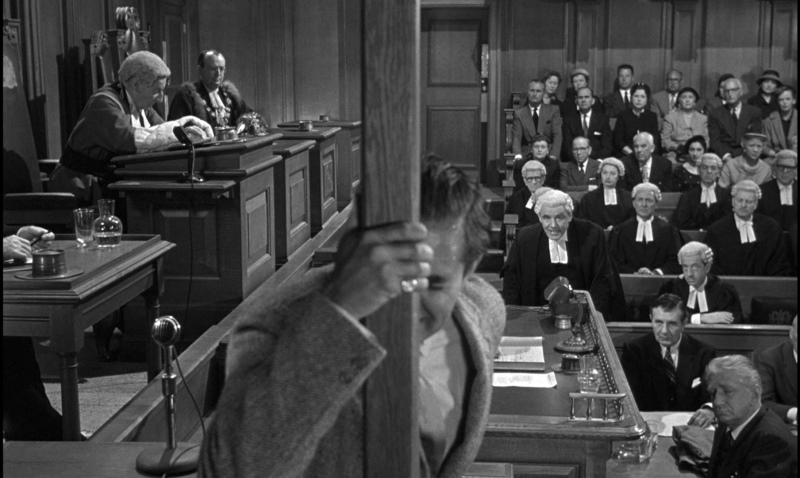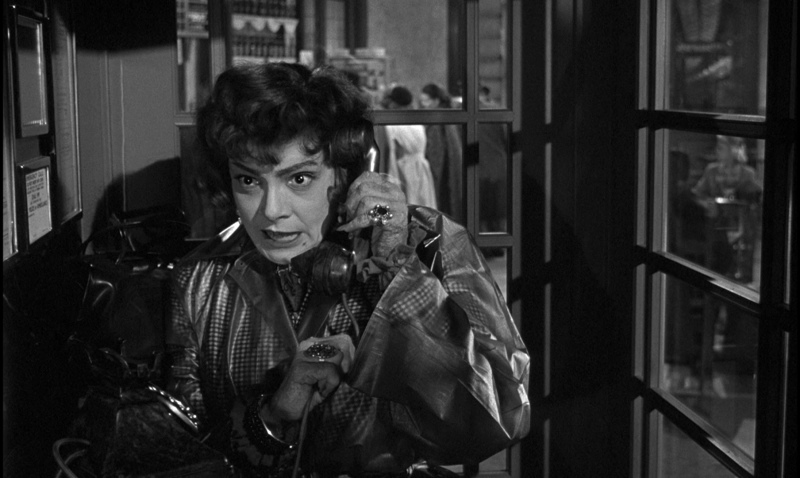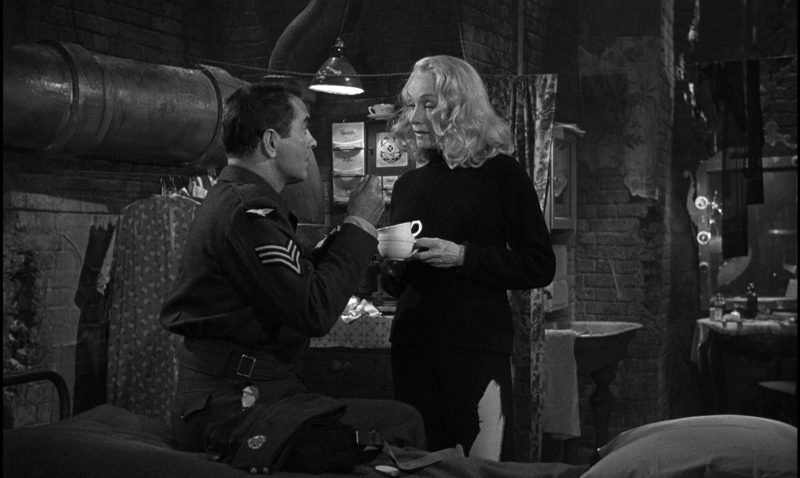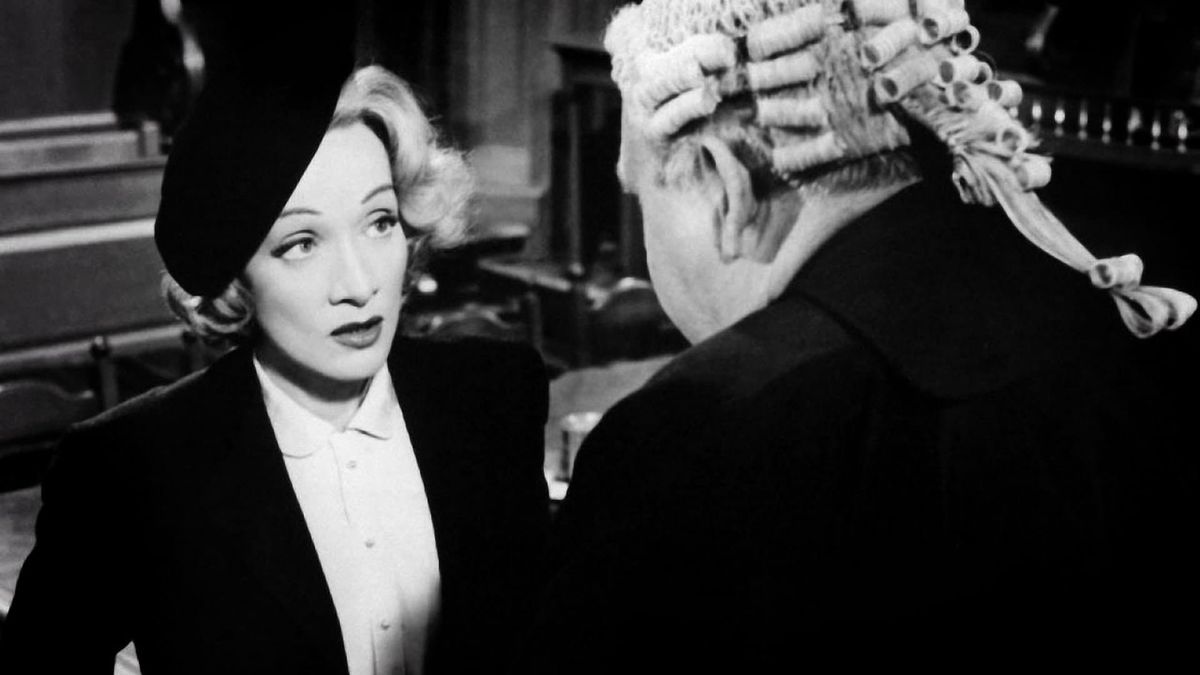Welcome to our Colossus Movie Guide for Witness for the Prosecution. This guide contains everything you need to understand the film. Dive into our detailed library of content, covering key aspects of the movie. We encourage your comments to help us create the best possible guide. Thank you!
What is Witness for the Prosecution about?

Witness for the Prosecution (which earned six Academy Award nominations, including Best Actor, Best Director, and Best Picture) operates on the surface as a gripping courtroom drama, but beneath the thrilling plot twists and sharp dialogues lies a layered exploration of human nature, the fragility of truth, and the complicated reality of our justice system. The story’s convoluted narrative delves into the intricate dance of deception, loyalty, and human fallibility. At its core, the film wrestles with the question of how well one can truly know another, and the lengths to which individuals will go to protect or betray those they love.
These themes are presented in a world where the legal system serves as a backdrop, highlighting the subjective nature of truth (recalling themes famously explored by movies like Rashomon). Multiple accounts of the same events introduce a blurred line between fact and fiction, asking the audience to continuously reassess their perceptions of characters and their motivations. This unreliability serves to amplify the film’s core message: that truth is multifaceted, perception is malleable, and human motivations can be as unpredictable as they are complex.
All of these questions help inform the film’s examination of class conflict and occupational identity. We actually know very little about anyone in the film besides their occupation, so people like Wilfrid are completely defined by their profession and the wealth he’s accrued from it. Contrastingly, all we know about Leonard is his inability to gain work, making him entirely defined by his low class status. Plus, the little we do learn about Leonard and Christine’s personal lives often fluctuates between reality and fiction—which causes Wilfrid to question the legal system he’s dedicated his life to and the nature of justice. These various paths converge at the movie’s end to raise questions about the subjectivity of truth and how we choose to see the world and how we can improve it.
Movie Guide table of contents
Cast
- Charles Laughton – Sir Wilfrid Robarts
- Tyrone Power – Leonard Vole
- Marlene Dietrich – Christine Vole/Helm
- Elsa Lanchester – Miss Plimsoll
- John Williams – Mr. Brogan-Moore
- Henry Daniell – Mr. Mayhew
- Ian Wolfe – H. A. Carter
- Torin Thatcher – Mr. Myers Q.C.
- Norma Varden – Mrs. Emily Jane French
- Una O’Connor – Janet McKenzie
- Francis Compton – Mr. Justice Wainwright
- Philip Tonge – Chief Inspector Hearne
- Ruta Lee – Diana
The ending of Witness for the Prosecution explained

A recap of Witness for the Prosecution‘s ending
Following Leonard’s surprising acquittal, an atmosphere of mixed reactions engulfs the courtroom. The jubilant crowd celebrates the verdict—but an underlying tension is palpable around Sir Wilfrid, who harbors doubts about the outcome.
In the courtroom’s aftermath, Christine is shielded for her safety from an agitated crowd angered by her seemingly treacherous testimony. Once inside, she unveils her elaborate ruse to Sir Wilfrid. She confesses that she had masterfully orchestrated the entire scenario: playing the role of a wife testifying against her husband and then discrediting her own testimony using forged letters. This elaborate scheme was her solution to Sir Wilfrid’s prior assertion that a loving wife’s alibi would be dismissed by the jury. Despite knowing of Leonard’s guilt in Mrs. French’s murder, Christine’s deep-seated love for him compelled her to safeguard his freedom.
Eavesdropping on this revelation, Leonard candidly admits his guilt in the murder of Mrs. French. Sir Wilfrid, bound by the intricacies of legal protocols and double jeopardy laws, is unable to pursue any legal recourse against Leonard. The realization that he has been an unwitting participant in this deceit leaves Sir Wilfrid visibly distraught.
The story takes another turn when Christine discovers Leonard’s betrayal. Learning of his affair with a younger woman and his intentions to leave her, she is consumed with rage. In an emotionally charged moment, she grabs the knife, which had been pivotal evidence during the trial, and fatally stabs Leonard.
The cycle of legal proceedings begins anew as Sir Wilfrid, despite his weariness and the complex feelings stemming from the recent case, decides to defend Christine in the ensuing trial, suggesting that the wheels of justice and deception are in perpetual motion.
The meaning of Witness for the Prosecution‘s ending
In Witness for the Prosecution, the depiction of the judicial system is a nuanced reflection on the malleability and, sometimes, impotence of institutional justice. The film provides a stark commentary on the irony that, while the law can be manipulated and circumvented, there remains an inherent balance—often poetic in nature—that seeks to right the scales.
Throughout the narrative, we observe that the legal process is vulnerable to deception. Christine’s masterful orchestration showcases how the law can be exploited by using its own rules and expectations against itself. Leonard’s subsequent acquittal becomes a glaring testament to the system’s fallibility, illustrating that truth and justice aren’t always aligned within the confines of a courtroom. The courtroom, with its rituals, procedures, and reliance on evidence, is depicted as a stage where actors play their parts and outcomes can be shaped by cunning and emotion rather than mere facts.
However, in a twist laden with irony, Leonard’s comeuppance doesn’t arise from the courtroom battle he’s just won, but from personal betrayal in its rawest form. The film’s resolution underscores the idea that while man-made systems can be manipulated, there’s a deeper, almost cosmic sense of justice that can come into play. Leonard, untouched by the legal system, meets a violent end at Christine’s hand—a direct consequence of his own betrayals.
This climax, laden with irony, holds particular significance for Sir Wilfrid’s character arc. As a legal stalwart, he’s faced with the disillusioning reality that the justice system is not infallible. However, Leonard’s death and the unfolding drama reignite his professional vigor. It’s as if witnessing the frailties of his beloved legal realm and its eventual, if unconventional, meting out of justice reinforces his belief in its value. This chain of events serves as a reminder of the profound influence of his profession on his identity (an important theme in the film).
Sir Wilfrid’s decision to defend Christine post-Leonard’s death further accentuates this. Despite the convoluted maze of deceptions he’s just navigated, he remains undeterred—even given his flailing health and self-destructive lifestyle. He’s reinvigorated, ready to plunge back into the fray, underscoring his unwavering commitment to justice, irrespective of the personal disillusionments he’s endured.
The themes and meaning of Witness for the Prosecution

The confines of class constructs
In Witness for the Prosecution, class conflict is an undercurrent that subtly drives characters to make decisions steeped in desperation, manipulation, and self-preservation. The movie presents an intersection of personal desires and socio-economic motivations, shaping the behaviors of Leonard and Christine and highlighting the extents they go to escape the confines of their social standings.
Leonard, as a man of poor and low-class status, embodies the struggles of those trapped in the socio-economic ladder’s lower rungs. Emily French, the wealthy widow, represents an opportunity for Leonard—a gateway to a better life, free from the suffocating constraints of his class. In the film, Leonard’s relationship with Mrs. French isn’t just a simple romantic entanglement, but emblematic of his aspiration for upward mobility. His involvement with the widow underscores the lengths individuals might go when lured by the promise of wealth and a higher social standing. The ensuing murder, while driven by various factors, is also an extreme manifestation of the pressures and allure of escaping his socio-economic situation.
Christine’s backstory, fleeing from the hardships post-war Germany presented, adds another dimension to this theme. Her desire to leave behind a war-torn country and find solace and stability in England is rooted in her pursuit of safety, security, and a better class standing. While her actions in the courtroom are driven largely by her complex feelings for Leonard, it’s undeniable that her overarching motivation throughout their relationship was an escape from her past and a hope for a brighter, more prosperous future.
The legal system in the film is not just a backdrop for the unfolding drama but rather a mechanism that the characters attempt to manipulate for personal gain. Leonard and his German wife’s calculated moves to deceive the court aren’t just about proving innocence, but about crafting a new narrative for themselves, one where they aren’t bound by the shackles of their class. Their manipulations highlight a profound commentary on how social pressures and the desire for a better life can drive individuals to exploit even the most sacred of systems.
How our jobs define us
Occupational identity stands as a potent theme in Witness for the Prosecution, serving as both a mirror reflecting characters’ moralities and a lens through which they interpret the world. The film offers a compelling exploration of how professions, or the lack thereof, can wholly define an individual’s worldview, actions, and judgments.
For Sir Wilfrid, the legal profession isn’t merely a job—it’s an embodiment of his identity. Throughout the movie, he wrestles with the moral complexities and ethical dilemmas presented by the case. This internal battle reflects the larger conflict of his profession: the pursuit of truth and justice in a system that, as he painfully discovers, can be manipulated. By the end, his experiences with Leonard and Christine’s deception leave him disillusioned, causing him to question not just the verdict but his faith in the very system he has served. His entire perception of right and wrong, fair and unjust, is anchored in his role as a barrister. The case shakes the very foundation of his occupational identity, forcing him to grapple with the judicial system’s vulnerabilities and, by extension, his place within it.
As The Directors Series points out, Leonard’s character arc is uniquely defined by what he lacks: a stable job. This absence casts a shadow over him, influencing both public perception and his personal relationships. In a society where one’s profession is equated with identity, Leonard’s lack of a job doesn’t just brand him as low-class—it makes him a blank canvas, more susceptible to suspicion and prejudice. This lack of occupational identity is further exacerbated by the absence of a moral or ethical anchor, making him more malleable and, as the plot reveals, more capable of deception and malevolence.
In totality, the film portrays how occupations, or their absence, don’t just dictate social status but shape an individual’s very essence. Characters are viewed and understood largely through their professional roles. The narrative gives little insight into their lives outside of these roles, underscoring the idea that occupations are not merely jobs but defining elements of identity.
The film suggests that one’s occupation can be a double-edged sword. While it provides structure, purpose, and societal standing, it can also confine, define, and sometimes even blind individuals to broader truths and realities. For instance, Sir Wilfrid’s unwavering belief in the judicial system initially prevents him from seeing the intricate web of deception spun around him.
Why is the movie called Witness for the Prosecution?

The title “Witness for the Prosecution” at its most superficial level indicates a story centered around a court trial, where witnesses play crucial roles in establishing the guilt or innocence of the defendant. However, as we delve deeper into the narrative and its intricacies, the title begins to unravel layers of meta significance. Christine and the other trial participants aren’t the only witnesses for the prosecution—we are part of the judgment as well. And the film very much toys with our ability to judge in a fair and constructive way without bringing our own biases into the picture.
Witness to human deception
The word “witness” often evokes an image of someone who presents an objective, unbiased account of events. However, the film is a rich tapestry of deceit, manipulation, and ulterior motives. Christine becomes the most pivotal “witness” in the narrative, but her testimony is anything but straightforward. She embodies the complex relationship between personal emotions and objective truth—and, ultimately, the subjectivity of truth. In bearing witness against her husband, she serves the prosecution’s narrative, yet she simultaneously orchestrates a scheme that discredits her own testimony. This dynamic underscores the fragility and unreliability of human testimony, challenging the audience to question the very nature of witnessing. Are you seeing what you think you’re seeing? Or is your vision clouded and corrupted by your beliefs?
The witness as an actor
In the theater of the courtroom, every individual becomes a witness, not just in the legal sense but also in a theatrical one. The drama unfolds as characters wear masks, playing roles designed to elicit specific reactions from the jury and the audience. The title thus emphasizes the performative nature of the trial process. Witnesses don’t merely recount events, but construct narratives, consciously or subconsciously colored by personal biases. The courtroom transforms into a stage where the line between reality and performance blurs.
Witnessing one’s own morality
Sir Wilfrid, an embodiment of the legal profession’s ideals, becomes a witness to his own moral compass. As he navigates the maze of the trial, he confronts the dissonance between the law and human nature. His belief in Leonard’s innocence, stemming from the initial “monocle test,” is questioned as the narrative unfolds. By the film’s end, Sir Wilfrid is not just a witness to the events of the trial but also to the flexibility of his own judgments and beliefs. The title, in this context, reflects the introspective journey of characters as they bear witness to their own moral and ethical boundaries.
Witnessing the limitations of justice
The judicial system, represented by the courtroom proceedings, becomes a focal point where its vulnerabilities are laid bare. As the drama unfolds, the audience becomes a witness to the imperfections of a system they might have once regarded as unwavering. The title serves as a constant reminder that while the mechanics of justice—like gathering evidence and testimonies—are essential, they are prone to manipulation. The court, in seeking witnesses for the prosecution, can sometimes be blindsided, failing to capture the complete truth.
Witnessing the complexity of relationships
Beyond the legal drama, at the heart of the film lies the intricate web of human relationships. Leonard and Christine’s tumultuous relationship, marked by deceit, love, betrayal, and sacrifice, offers a microscopic view into the complexities of human emotions. The title, in echoing the role of a witness, underscores the challenges of truly understanding and interpreting human behavior. Just as a witness’s testimony can be multifaceted and laden with hidden motives, human relationships too are seldom what they seem on the surface.
Important motifs in Witness for the Prosecution

Unhealthy habits
Sir Wilfrid’s unhealthy lifestyle isn’t just a background detail—it stands as a symbolic manifestation of his obsessive commitment to the legal profession and the judicial system. His health and choices, both in and out of the courtroom, offer rich commentary on the lengths to which an individual will go for a vocation, driven by both passion and an unyielding sense of duty.
Sir Wilfrid’s decision to take on Leonard Vole’s case despite his recent heart attack signifies more than just professional commitment—it paints the picture of a man who finds purpose and identity in his profession. He’s not merely a barrister, but he embodies the very essence of justice-seeking, to the point where stepping away, even for his health, seems an alien concept. His very being is intertwined with the courtroom, and his unhealthy lifestyle underscores this relentlessness.
While Sir Wilfrid’s physical health deteriorates, he remains morally vigilant. This juxtaposition offers a compelling exploration of personal sacrifice in the face of duty. Sir Wilfrid’s disregard for his well-being is symbolic of the toll the pursuit of justice can have on an individual. It suggests that the moral and ethical battles in the courtroom can sometimes overshadow, or even be in direct conflict with, the battles of personal well-being.
On a broader level, Sir Wilfrid’s ill health acts as a metaphor for the larger judicial system. Just as he pushes himself, ignoring clear signs of distress, the legal system too, as portrayed in the film, often overlooks its inherent flaws and vulnerabilities. Sir Wilfrid’s determination to keep going, even at the risk of his health, mirrors the judicial system’s relentless grind, sometimes at the expense of truth and justice. In fact, unhealthy habits, such as drinking brandy and smoking cigars, fuel his vigor as these practices always have. Shying away from them would be shying away with the ruthless investigator he’s become.
Sir Wilfrid’s character presents a poignant paradox. His physical vulnerability contrasts starkly with his relentless pursuit of justice. This duality underscores the idea that while the body may wane, the spirit, driven by duty and passion, can remain unyielding. His frequent clashes with Miss Plimsoll over his health choices emphasize this tension between personal care and professional duty, further highlighting the sacrifices he’s willing to make for the cause of justice.
The monocle
Sir Wilfrid’s monocle in Witness for the Prosecution is more than just a mere accessory—it’s a complex symbol, one that encapsulates the inherent challenges in discerning truth from deception. The monocle, traditionally an instrument to aid sight, comes to signify both clarity and obfuscation in the narrative, making it a pivotal motif in the film’s exploration of truth and perception.
Early in the movie, Leonard Vole undergoes what Sir Wilfrid internally deems as the “monocle test.” As Sir Wilfrid scrutinizes Leonard through his monocle, he seeks signs of deceit or guilt. Believing that Leonard has passed this initial test, Wilfrid’s reliance on his own judgment, facilitated by the monocle, sets the stage for the subsequent unraveling of events. It underscores the human tendency to trust empirical tools and observations, even in matters as intricate and nuanced as human behavior.
The irony lies in how the monocle, designed to enhance vision, blinds Sir Wilfrid to deeper truths. His faith in his ability to read Leonard’s innocence through the lens of his monocle showcases the dangers of overconfidence in one’s own judgments. Just as a monocle can magnify and clarify, it symbolically in this case restricts and limits one’s field of vision. In doing so, it becomes a metaphor for the selective perceptions humans adopt, focusing on some truths while being oblivious to others.
Throughout the film, the monocle acts as both a revealer and concealer. While it helps Sir Wilfrid in some aspects of the case, shedding light on certain pieces of evidence or emphasizing moments of realization, it also becomes emblematic of his larger misjudgments and misconceptions. This duality in the monocle’s symbolic role enriches its significance. The very instrument that aids Sir Wilfrid’s discerning sight becomes a metaphorical blindspot, highlighting the limitations of relying solely on surface-level observations.
Questions & answers about Witness for the Prosecution

How does Witness for the Prosecution differ from the source material?
Witness for the Prosecution began its life as a short story by the acclaimed mystery writer Agatha Christie. The story was first published in 1925 under the title Traitor Hands. Given Christie’s adeptness at crafting tight, compelling mysteries, it was a hit with her readership. The tale was later adapted into a successful play by Christie herself in 1953 before being turned into the renowned film directed by Billy Wilder in 1957.
Here’s a breakdown of some of the differences between Christie’s original story and the film adaptation:
- Expansion of characters: The characters in the film, especially Sir Wilfrid Robarts, are more fleshed out compared to the short story. Sir Wilfrid’s health issues and the character of Miss Plimsoll, his nurse, are unique to the film, adding more layers to his character and integrating a touch of humor to the proceedings.
- Differences in plot details: While the fundamental twist and core storyline remain consistent between the two versions, there are nuanced differences. For instance, the dynamics between Leonard Vole and Christine (her name is Romaine in the book) and their backstories are more elaborated upon in the film, giving greater depth to their motivations.
- Setting and atmosphere: The courtroom scenes in the movie are more intense and dramatic than in the short story, leveraging the visual medium’s strengths. The grandeur of the Old Bailey, the reactions of the jury, and the exchanges between the prosecution and defense all add to the film’s atmosphere, making it more engaging.
- Ending: While the core twist remains intact, there are differences in how the story concludes. Without giving too much away, the film’s ending is more dramatic and offers more closure compared to the somewhat open-ended nature of the short story.
- Themes and motifs: The film, especially under Wilder’s direction, introduces additional themes and motifs not present or only subtly hinted at in the original story. For instance, Sir Wilfrid’s monocle and his health concerns add layers of meaning about perception, deception, and the personal toll of seeking justice.
- Dialogue and wit: Billy Wilder, known for his sharp dialogue, infused the script with more wit and humor than present in Christie’s original tale. This is especially evident in exchanges between Sir Wilfrid and Miss Plimsoll, providing moments of levity amidst the suspense.
Now it’s your turn
Have more unanswered questions about Witness for the Prosecution? Are there themes or motifs we missed? Is there more to explain about the ending? Please post your questions and thoughts in the comments section! We’ll do our best to address every one of them. If we like what you have to say, you could become part of our movie guide!

